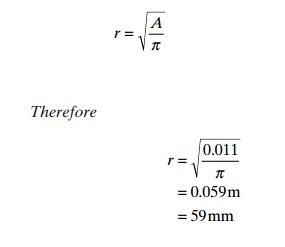Chapter: Aquaculture Engineering : Water Transport
Water flow in channels and pipe systems
Water flow and head
loss in channels and pipe systems
Water flow
The amount of water that flows through a pipe or in an
open channel depends on the water velocity and the cross-sectional area of the
pipe or the channel where the water is flowing. The following equation may be
used for pipes and channels; it is also called the continuity equation:
Q = VA
where:
Q =water flow (l/min, l/s, m3/s) V =water velocity (m/s)
A =cross-sectional area of where the water is flow-ing. For
full pipes the cross-sectional area will be the interior cross section of the
pipe.
The above equation can be used as a basis for construction
of a chart. If two of the sizes are known the last can be read from the chart
and no calculation is necessary. Often the head loss is also included in the chart
(see below).
Example
The water flow to a
farm is 1000 l/min (0.0167 m3/s). The acceptable
velocity in the pipeline is set at 1.5 m/s. Find the necessary pipe dimensions if one pipe is to be used.
= Q/V
= 0.0167/1.5 = 0.011 m2
Now
A =pr2
where:
r is the internal
radius of the pipe and rearranging gives

The internal
diameter in the pipe must therefore be 2 × 59 = 118 mm. Standard
dimension pipes are available with an exterior diameter of 125 mm; a PN6 pipe
with a wall thickness of 6 mm (supplier information) therefore has an internal
diameter of 113 mm. This is actually slightly too small, but as the next
stardard exterior dimension is 160 mm, it is best to choose the 125 mm pipe.
This will result in the water velocity being slightly higher.
For an open channel the flow velocity depends on the
slope, the hydraulic radius and the Manning coefficient. The Manning equation
is used to calculate the flow velocity:

where:
V =average flow velocity in the channel R =hydraulic radius
S =channel slope
n =Manning coefficient.
The hydraulic radius is the ratio between the
cross-sectional area where the water is flowing and the wetted perimeter, which
is the length of the wetted surface of the channel measured normal to the flow.
R = cross-sectional area/ wetted
perimeter
To achieve water transport through the channel it must be
inclined. The slope is defined as the ratio between the difference in elevation
between two points in the channel and the horizontal distance between the same
two points.
Example
The horizontal
distance between two points A and Bis 500 m. Point A is 34 m above sea level
and point Bis 12 m above sea level. Calculate the slope (S) of the channel.
= (34 m − 12 m)/500 m
= 0.044
= 4.4 cm/m
This means that for each metre of elevation the horizontal
distance is 22.7 m.
To ensure drainage, it is recommended that the slope is
more than 0.0013, while self-cleaning is ensured with slopes in the range
0.005–0.010.
The Manning coefficient is determined by exper-iment, some
actual values being about 0.015 for concrete-lined channels and 0.013 for
plastic, while unlined channels made of straight and uniform earth have a value
of 0.023 and those made of rock 0.025.
Based on the flow velocity and the cross-sectional area,
the flow may rate be calculated with the con-tinuity equation which also can be
expressed as:

where:
Q =water flow
A =cross-sectional area where the water is flowing
V =average flow velocity in the channel
R =hydraulic radius
S =slope of the channel
n =Manning
coefficient.
Related Topics